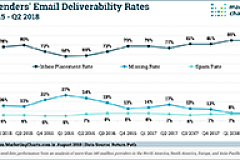 In the US, successful advertising campaigns are celebrated as though they are part of the national culture. Unfortunately, some adverts done in the past have failed the marketers miserably. As a marketer, you will be interested to know how the effectiveness of an advertising campaign can be measured.
In the US, successful advertising campaigns are celebrated as though they are part of the national culture. Unfortunately, some adverts done in the past have failed the marketers miserably. As a marketer, you will be interested to know how the effectiveness of an advertising campaign can be measured.
[quotes]Finding an answer to the question is a complicated process.[/quotes] The media mixes, numerous channels, and multiple devices used in trying to come up with a solution do not make it any easier. Moreover, there is no one right answer when it comes to measuring effectiveness.
For a business to succeed, it must develop advertising campaigns. Publishing the adverts isn’t the end of the road because the campaigns’ overall success must still be measured. [quotesright]The results are an indication whether the business is on the right track with its efforts of not. [/quotesright]
Here is a guideline on how the effectiveness of an advertising campaign can be measured:
Analyze the Predictive Analytics and Marketing Metrics
Predictive analytics entail the use of statistics to determine and examine patterns in data with the goal of uncovering causation through correlation. If you observe 400 dogs that almost always bark at strangers, you can hypothesize that if you like to hear dogs bark, all you need to do is find strangers and let the dogs see them.
It’s a way to pre-analyze and predict the likely outcome of your campaign, more like the "Moneyball" approach measuring the effectiveness of an advertising campaign.
[quotes]Predictive analytics help companies find patterns within observed consumer behavior and then predict future consumer behavior.[/quotes] Using “big data” and survey panels that can be applied to contact databases or even customer files, allows you to create “look alike” models. This in turn gives you the ability to identify likely prospects.
If you find observable attributes in large databases that you can correlate with the behavior of existing customers, you can create very powerful marketing tools to select only the best prospects to contact. This minimizes your marketing costs and maximizes your ROI.
Shopping habits and purchasing tendencies can be measured using the predictive analytics. [quotesright]Now you know why having individual-level data is of utmost importance. [/quotesright] It’s why using social platforms such as Facebook, Amazon or Google attract big ad money; they have deep data that marketers tap into in order to efficiently reach their best prospects.
Marketing Metrics
The use of marketing metrics is a fundamental approach to measuring advertising success because metrics measure effectiveness in terms of output. Marketing metrics help gauge related outputs in comparison to inputs, such as costs.
For example, operational metrics can measure sales per square foot of store space to assign a sale costs based on the space required to display a given product. The parameters have to be tailored to match the company's operations since they are unique to each firm.
[quotesright]There are also more global measures that help you make more profitable marketing decisions. [/quotesright] There is almost always one objective of a campaign, say number of sales made or total dollars generated. Perhaps it will be the number of people added to a prospect database. There are more than 100 metrics that can be used to measure different attributes within a marketing campaign.
Yogi Berra would probably have said something like, “Measure what you expect or you won’t see if you got what you expected.” It’s sound advice. [quotesright]If you don’t measure what happened, you’ll never know what worked or didn’t, nor can you intelligently make changes to see if you can improve your results. Measure! [/quotesright]
Marketing Metrics in Detail
Marketing metrics enable a company to measure their return on investment. Any responsible company will make a point of measuring how much it is getting from the investment it makes.
One of the effective ways to do this is to look at the numerical data that give some perspective on a specific advertising campaign. Through the numbers, it is possible to see if the goals of the company have been met.
Data can be generated from specific marketing metrics like:
1. Web Content
You can check the effectiveness of your website content in achieving your marketing objectives. Capture the action visitors take on your site. [quotesright]How well did your copy, images, web design, SEO, or visitor journey work? [/quotesright]
That is, did your page result in the action you expected it would? No? At least now you have a quantifiable number you can try to improve by systematically tweaking your page copy, images, flow, etc.
2. Lead Conversion
[sidebar]
Want to Learn More?
If you're looking for more ways to grow your business, improve your results, and find new strategies, let’s talk. USA: 877.433.6225 feedback@focalpointcoaching.com
[/sidebar]
This metric entails gathering data that show how customers progress through the lead generation process. Check each stage in their progress from the point when a customer comes into contact with your marketing strategy to the point where you close a sale. [quotesright]This will help you track where potential customers drop out. [quotesright]
3. Individual Visitors
This metric enables you to track when an individual user comes to your website for the first time for a specific period. It also checks how many times they come back to your website. It shows how the effectiveness of an advertising campaign can be measured by helping analyze the impact of each phase.
You’ll learn how many times prospects visit before making a purchase decision or decision to get in contact with you. What do they go back and look at? [quotesright]Metrics inform your marketing decisions and help you perfect your website content. [/quotesright]
4. Keeping track of new and returning visitors
This marketing metric enables you to determine the usefulness of new site content for driving traffic to your site. It is not very easy to get accurate results. This metric may best be answered by conducting a survey. You may want to find out why people came to your site the first time and come back later.
5. Click Through Rate (CTR)
CTR probably provides the best analysis for a web page that has a call to action. The metric takes into account the number of people who visit the webpage and proceed to the actionable step. It also compares this number to those who do not respond to the call of action. [quotesright]It’s an important metric to measure and optimize. [/quotesright]
6. Page Views
This analysis looks at how many pages each visitor to your site views. It can also be used to check how much time visitors spend on each page. This allows you to determine the pages that have the most appeal.
7. Bounce Rate
It is a sensitive metric that can lead to loss of jobs for marketers. Bounce rate is a measurement that tells you how many viewers visit the web pages but do not take any actionable steps.
Poor engagement can mean you are targeting or attracting the wrong audience or it can mean your web landing page doesn’t capture visitors’ interest immediately, letting them know within five seconds that you might be the solution they are looking for.
8. Search Engine Traffic
Most search engines have a way of tracking the keywords that site visitors use. To make your work easier in applying this metric, you may want to use the Google Analytics tool. An increase [quotesright]in search engine traffic means your SEO campaigns are working but you need to also examine if those coming are bouncing or not buying. [/quotesright]
9. Social Media Analysis
The effectiveness of an advertising campaign can be measured through platforms like Facebook and Twitter. Most social media sites have tools explicitly built for tracking customer engagement and response.
10. E-mail Opening
Use an email tracker to show how many emails were opened in comparison to those you sent out. The figure gives you an idea of how many potential clients you could get from the campaign. Think of open rates as approximations at best; email can’t be measured as precisely as website activity. You might have a relatively low open rate, but everyone made a purchase. Message: it isn’t just the number, it’s the number in relation to what you are selling. Dig deeper and really understand what the number is telling you about your business.
Measuring the Retention Rate
The effectiveness of a marketing campaign can be measured through an indicator like retention rate. This approach helps your business see how many individuals continue to buy from you more than one time.
Just because a product makes a lot of sales with its initial release does not guarantee a high retention rate.
[quotes]Focusing on increasing the retention rates is usually more profitable for a business than trying to get new clients.[/quotes] This justifies the retention rate metric for measuring the effectiveness of a marketing campaign.
Analyzing Search Marketing Position Ranking
Google Analytics comes in handy in helping you measure website visitor traffic and visitor behavior. But there are other measures that are relevant when assessing your marketing beyond just what you’ll see on Google Analytics.
• SEO Position: [quotesright]“You have to be found before they can buy.” Search engine optimization is crucial to any business that wants to succeed online. [/quotesright] You want to be found on page one of a Google search, so ranking as highly as possible for your product or service is obviously going to be critical.
SEO ranking is a factor that indicates the success rate of your website marketing campaign and SEO actions, such as the quality and frequency of your blog posts, links back to your site, plus many more factors. Google and other search engines are always tweaking and changing the criteria they look at when assigning an SEO ranking.
There are books on how to improve your ranking and frankly, you really need professionals who do this sort of thing to compete for top ranking.
• PPC (Pay-per-click ads). PPC refers to a code that is hidden behind a webpage that helps you monitor conversions from all tracking conversions.
• Print Ad Links Effectiveness. This is measured by creating a dedicated webpage and using its URL in the printed ad copy. When a visitor comes to that unique page, it is recorded so you can measure the print ad’s effectiveness at bringing people to your site. [quotesright]Better yet, you now have the opportunity to develop that visitor into a buyer. [/quotesright]
Don’t Get Confused About What Really Counts
All the possible metrics you can measure are means and not the ends – don’t confuse activity for results. [quotes]There is only one measure that counts and that is SALES.[/quotes] Always measure your results in terms of dollars sold vs. dollars spent on PPC, SEO, Click-throughs, Ad Links, etc. View them all in terms of How much did we make?
It seems obvious, but the number of campaigns that never get measured in terms of sales and profit per dollar spent is amazing. Doing this calculation takes effort but unless you love to lose money, measure the result that really counts.
Tools for Measuring the Effectiveness of Your Advertising Campaign
Now that you know how the effectiveness of an advertising campaign can be measured, have a look at the tools that you can use. Google analytics is the most commonly used, but there are additional ones that can make it easier:
1. Kissmetrics
Kissmetrics is also known as funnel reporting and it aims at bringing more traffic to the website. It comes with features such as:
- Enabling you to establish the marketing programs that have the most significant impact on your revenue.
- Analyzing results so you can focus your marketing budget on the areas where it has the best results.
- Simplifying your marketing metrics by making your efforts focus on specific approaches.
- Delivering monthly, weekly, or daily reports depending on how you set it up.
2. Marketo
Marketo is popular among many marketers because it converts sophisticated data into simple information for easy interpretation. You can use it to generate daily or monthly reports as necessary.
3. RapidMiner
RapidMiner is the easiest tool to use among the analytics platforms. It is best applied in data mining, predictive analytics, and machine learning. With it, you can easily connect business processes to essential data.
How the Effectiveness of an Advertising Campaign Can Be Measured - Final Thoughts
It is a competitive world and guessing at what is working in your marketing campaigns is not enough; your competitors are probably already analyzing their results, working on their SEO rankings, and doing their best to take your market share.
There are tools to help you track results, and especially for your website traffic. Properly processing of the data and analyzing the results can help determine the effectiveness of marketing campaigns.
For many years, companies did not know how to measure the effectiveness of an online advertising campaign. The common approach was simply checking actual sales. [quotesright]With the many changes in the business world, a marketing campaign may fail to increase sales. [/quotesright]
For solid feedback that will help with future marketing campaigns, you need to prioritize your measurement techniques. Start with those that are the easiest to use and analyze. This should help you optimize your marketing campaigns for a higher success











